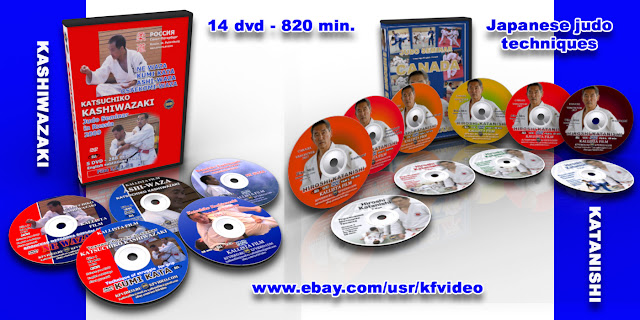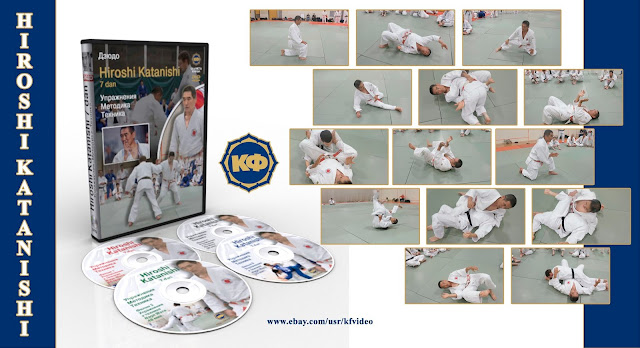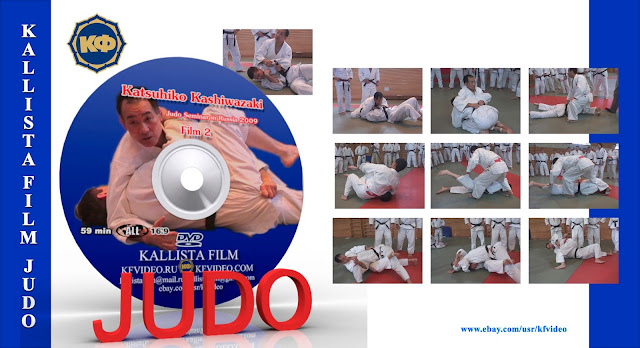Judo seminar. Hiroshi Katanishi 8 dan. 2017.

Fast shipper, no issues
Hiroshi Katanishi is an expert of the European Judo Federation.
Specialist of the highest class. Conducts seminars around the world in
the framework of the project "Improve your club". Winner of the 8th dan.
This is the most sought-after expert compared to 20 other specialists
working on this project. It is easier to name the countries where he has
not been yet than to list his seminars. It should be noted that the
judo technique, which he demonstrates at the seminar, is completely
based on the Japanese school of education. Date of birth March 11, 1952.
At the time of the seminar in Canada (Vancouver), he was 65 years old,
although it is difficult to believe in it.

Judo
technique, which Katanishi analyzed at the seminar. It should be noted
that all technical actions were in the standing position from the NAGE
WAZA section.
Disk 1 - the technique of the tricks okuri-ashi-barai, ko-uchi-gari, okuri-ashi-harai.
Disk 2 - the technique of o-uchi-gari tricks.
Disk 3 – the technique of ippon-seoi-nage tricks.
Disk 4 – the technique of okuri-ashi-barai, de-ashi-barai, ko-uchi-gari tricks.
Disk 5 – the technique of o-soto-gari tricks.
Disk 6 – the technique of o-soto-gari tricks.
In
addition to these tricks, another technique was considered. Katanischi
is a good demonstrator. He always supports all his explanations with a
real throws. The seminar is designed for coaches working with children
of 8 years and older.
Short biography of Hiroshi Katanishi.
8th dan is an expert at Tenri University (Japan).
Technical
consultant of the Swiss Judo Federation, as well as technical
consultant of the judo magazine "Lesprit-ju-judo". H. Katanishi teaches
Judo in Lausanne, Switzerland.
03.11.1952 - Born in Kobe - Hero - Japan.
1970 - 1974 - Studied at the University of Tenri in Japan. 1974 - 1976 - coach of the French team.
Since 1976 - professional trainer and technical director of JKL.Since
1978 - an expert of Swiss dana in judo and jiu-jitsu.1979 - 1985 -
National coach of the Swiss women's team.1992 - 1997 - coach of the
Swiss national men's team.Since 1999 - Technical Advisor to the Swiss
team.Currently he regularly holds seminars on judo techniques and
methodics.
 Compilation is based on seminar held in Canada in 2011.
Disk 1.
Compilation is based on seminar held in Canada in 2011.
Disk 1. Exercises to technique Nage Waza - seoin-age, ippon-seoi-nage, kouchi-gari
65 min.
Disk 2 . Exercises to technique Nage Waza –sasae-tsurikomi-ashi, ouchi-gari,deashi-harai, okuri-ashi-harai
48 min.
Disk 3. Exercises to technique Nage Waza – uchi-mata
50 min.
Disk 4. Basics of ground fighting. Ne Waza. Movement. Changing positions of attack and defense Roll overs.
58 min.
In the seminar Katanishi examined the following topics:throwing
techniques; preparation of throw movement of the athlete; grip.The main
focus of the seminar is how to teach the technique of judo.This is seen
not only from the demonstration throws (Katanishi perfectly fulfills
throws), but also at the show, support assignments, exercises with a
belt. Also keep in mind that it is a Japanese method of teaching judo.
The film will be useful for all: who loves judo, who is engaged in judo, teaching and studying judo.
Technician of the Japanese judo Katsukhiko Kashivazaki.
In 2009, Katsuhiko Kashivazaki
conducted a judo seminar for coaches in the city of St. Petersburg. This
collection contains all 5 films. Conducting a seminar, Kashivazaki
touched upon three main topics: the ground fighting technique (newaza),
the fight for grappling technique (kumikata), and the other techniques
conducted mainly by the legs (ashi-waza). Kashivazaki is a great
specialist in the technique of ground fighting. Therefore, 3 films are
devoted to ground fighting and two films are devoted to judo techniques
and the struggle for capture. Kashivazaki showed a lot and explained
each judo technique. He always returned to the topic of children's judo.
Showed exercises for teaching children. The seminar will be useful
primarily for coaches working with children and teenagers, as well as
for experienced athletes.
 Before
Before
you the first part of the film. The main theme of the first film is the
technique and technique of performing osaekomi reception. The following
options are dealt with in the film: Yoko-shiho-gatame,
kami-shiho-gatame, head-tate-shiho-gatame, hon-kesa-gatame (hold on the
side), kuzure- kesa-gatame (hold on the side with a grip from under the
arm). In all varieties of osaekomi, he showed how to properly hold hands
grips, how to put his feet, how to arrange a trunk. Kashiwazaki showed
basic exercises for teaching children osaekomi techniques. The film will
be useful for all lovers of judo. For young athletes, for experienced
wrestlers, for professionals and coaches.
 Before
Before
you the second part of a seminar. Kashivazaki has found time for
various details which help to strengthen reception performance.He has
shown exercises for training of children in fight lying and has answered
questions of participants of a seminar. The movie will be useful to all
fans of judo. For young athletes, for skilled fighters, for experts and
trainers. Katsukhiko Kashivazaki was born on September 16, 1951 the
Japanese judoist. The silver prize-winner of the World Cups in 1975 and
the world champion in 1981. I have begun to do judo with the 5th class.
After the termination of the Tokaj university Tokai began to be engaged
at Ibaraki Prefectural Taga school and the University. I have finished
sports career in 1982. I worked as the national trainer in England,
Canada, Germany and other countries. Since 2009 he trains judo at the
International university Budo in Japan. I have written the book Fighting
Judo with Terence Donovan published in 1986 by the Pelham magazine. Is
the author of other books on judo and several methodical DVDs of movies.
The excellent specialist in technology of fight lying. The best expert
in Japan in tomoe-nage throw equipment (a throw through the head).
 Here
Here
is the third part of the seminar. In the third film, the main theme is
the techniques, conducted mainly by the legs. In Japanese terminology,
this is the section ashi-waza. Explaining the footwork technique for
different throws, Kashivazaki always reiterated that footwork increases
the chance of dealing with a strong opponent. It is necessary to start
teaching children from the section ashi-waza. Much attention in the film
is given to the foot sweeps section, as well as the technique of
ko-soto-gari. Kashivazaki gave this explanation for taking ko-soto-gari.
According to statistics of competitions held in Japan, ko-soto-gari
action is used most often. In the course of the seminar, Kashivazaki
constantly addressed the topic of how to teach children these
techniques, what exercises to give. The film will be useful for coaches
working with children, for athletes studying techniques from the foot
sweep section.
 This
This
is the fourth part of the seminar. In the fourth film, the main theme
is the struggle for grip. In Japanese terminology, this is the Kumi Kata
section. In this film you will see how to get rid of the capture of an
opponent, how to intercept the capture from the enemy, which capture is
not worth taking. Kashivazaki will show some tricks for capturing and
explain how to choose it. In the course of the seminar, he constantly
addressed the topic of how to teach children to take grips, what
exercises to give. The film will be useful for coaches working with
children, for athletes studying the section gripping in judo.
 This
This
is the fifth part of the seminar. The seminar ends with this film. The
main theme of this part is the ground fighting technique. In Japanese
terminology, this is newaza. You will see several roll overs in ground
fighting. Kashivazaki will explain and show from which positions the
sankaku roll over is performed. At the end of the film, Kashivazaki
talks about how he began to train, what difficulties he faced, how he
managed to enter the world stage, how he had to change his personal
technique as a result of several injuries. The film will be useful for
coaches working with children, for athletes and amateurs studying judo.



 Judo
Judo
 Compilation is based on seminar held in Canada in 2011.
Compilation is based on seminar held in Canada in 2011.
 Before
Before
 Before
Before
 Here
Here
 This
This
 This
This